 W
WBaekhyeon-dong is neighborhood of Bundang district in the city of Seongnam, Gyeonggi Province, South Korea.
 W
WBodeok-dong is an administrative dong or a neighbourhood in the administrative subdivisions of the Gyeongju City, North Gyeongsang province, South Korea. It consists of seven legal dong including Cheongun-dong, Sinpyeong-dong, Bukgun-dong, Sogok-dong, Deok-dong, Hwangnyeong-dong and Amgok-dong
 W
WBulguk-dong is an administrative dong or a neighbourhood in the administrative subdivisions of the Gyeongju City, North Gyeongsang province, South Korea. It consists of seven legal dong including Gujeong-dong, Sirae-dong, Si-dong, Joyang-dong, Jinhyeon-dong, Ma-dong and Ha-dong.
 W
WBundang-dong (Korean: 분당동) is one of the 19 dongs of Bundang-gu, Seongnam, South Korea. The total area is 3.40 km², with a population of 31,186. It is a quiet residential area with trees and parks, located at the foot of Bulgok Mountain. Taehyeon Park is close to the residential area. Different from other areas in Bundang-gu, houses in Bundang-dong mainly consist of 3-story villas and studio apartments rather than high-rise apartments. This quiet place has several upscale cafes and restaurants which attract people looking for a quiet place rather than busy places like Seohyeon Station. Bundang-dong consists of two small towns, Saetbyul town and Jangan town. It is close to Bundang Central Park and Yuldong Park. Two elementary schools and Daejin High School lie in Bundang-dong. The famous St. John's Cathedral is near Yuldong Park.
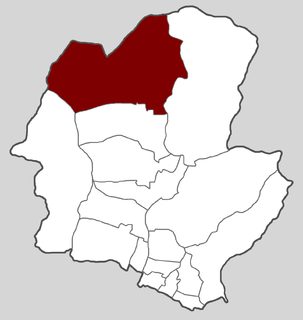 W
WCheongnyeongnopo is a dong, or precinct, in Geumjeong-gu, Busan, South Korea. It was created in 1998 when the former districts Cheongnyeong-dong and Nopo-dong were amalgamated.
 W
WDongcheon-dong is both an administrative and legal dong or a neighbourhood of the Gyeongju City, North Gyeongsang province, South Korea. It is bordered by Bodeok-dong on the east, Yonggang-dong and Seongdong-dong on the west, Bohwang-dong on the south and Cheonbuk-myeon on the north. Its 5.26 square kilometers are home to about 26,507 people. After the liberation of Korea, returnees from abroad were numerous; a village for them was constructed in present-day Dongcheon-dong
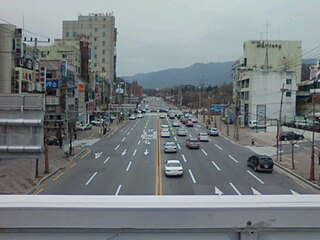 W
WDuryu is a dong in Dalseo-gu, western Daegu, South Korea. It is the site of Duryu Park and Woobang Tower Land, a popular Daegu amusement park. Although legally a single dong, Duryu-dong is divided into three administrative dong: Duryu-1[il]-, -2[i]-, and -3[sam]-dong. Together, the three administrative dong cover 2.44 km². They were home to 34,280 people as of October 31, 2005.
 W
WGeumgok-dong is neighborhood of Bundang district in the city of Seongnam, Gyeonggi Province, South Korea. It is officially divided into Geumgok-1-dong and Geumgok-2-dong.
 W
WGeumsahoedong is a dong, or precinct, in Geumjeong-gu, Busan, South Korea.
 W
WHwangnam-dong is a dong or a neighbourhood of the Gyeongju City, North Gyeongsang province, South Korea. It is bordered by Dodong-dong on the east, Tapjeong-dong on the west, Naenam-myeon on the south and Jungang-dong on the north. Its 20.5 square kilometers are home to about 8,885 people. It is both an administrative and legal dong.
 W
WHwango-dong is a dong or a neighbourhood of the Gyeongju City, North Gyeongsang province, South Korea. It is located in the central Gyeongju and is bordered by Bohwang-dong on the east, Jangang-dong on the west, Hwangnam-dong on the south and Seongdong-dong on the north. Its 1.5 square kilometers are home to about 10225 people. It is both an administrative dong and legal dong.
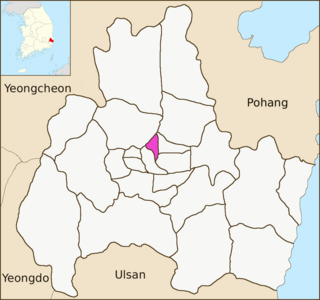 W
WHwangseong-dong is both an administrative and legal dong or a neighbourhood in the administrative subdivisions of the Gyeongju City, North Gyeongsang province, South Korea. It is bordered by Yonggang-dong on the east, Hyeongok-myeon on the west and north and Seongnae-dong on the south. Its 3.84 square kilometers are home to about 29,140 people. It has two elementary schools, three middle schools and one high school
 W
WJeomchon is the urbanized center of Mungyeong city, in Gyeongsangbuk-do province, South Korea. The name literally means "mountain-pass village", and may refer to the low hills that run along the edge of town. It has a population of about 45,000, on an area of roughly 45 km². Jeomchon comprises roughly the five dongs known today as Jeomchon 1-dong through Jeomchon 5-dong.
 W
WJeongja-dong (정자동) is a neighbourhood in the Bundang-gu district of Seongnam, Gyeonggi-do, South Korea. It is a very wealthy and relatively new neighbourhood, particularly on the western bank of the Tancheon. As recently as 2004, a view of this portion of Jeongja from the northern neighbouring Sunae-dong revealed primarily cranes and buildings under construction. By 2006, most of this construction was completed and several upscale businesses and affluent citizens had moved into the neighbourhood. The plaza between the Paragon apartments, I-Park apartments, and Santeview Apartments is particularly known for its Western-style cafes, and has been used for the filming of both television commercials, dramas, and magazine advertisements. Other residential flats include Adena Palace, Adena Luce, Parkview, Pavilion and Time Bridge. Head office of Naver Corporation and Korea Telecom and Bundang Police Station are also situated in Jeongja-dong.
 W
WJukjeon-dong is a dong in Suji-gu of Yongin city. Jukjeon was divided into Jukjeon 1-dong and Jukjeon 2-dong on December 24, 2001, when Suji-eup was promoted into Suji-gu. Jukjeon borders Seongnam city to the north, Mohyeon-Eup of Cheoin-gu to the east, and Giheung-gu to the south. Tancheon flows through the neighborhood, with west of the stream classified as Jukjeon 1-dong and the east of it classified as Jukjeon 2-dong. Jeongpyeongcheon, a stream, also flows into Tancheon at Jukjeon. Along the banks of Tancheon are small parks and paths for walkers and cyclists.
 W
WJungbu-dong is a dong or a neighbourhood of the Gyeongju City, North Gyeongsang province, South Korea. It is bordered by Songdong-dong and Hwango-dong on the east, Seonggeon-dong on the west, Hwangnam-dong on the south and Hwangseong-dong on the north. Its 0.93 square kilometers are home to about 6,894 people. It is an administrative dong that consists of five legal dongs such as Seobu-dong, Dongbu-dong, Bukbu-dong, Noseo-dong, and Nodong-dong.
 W
WOkpo is a neighborhood in the city of Geoje in South Gyeongsang Province, South Korea. The village is located on the eastern coast of Geoje Island and a center of the island.
 W
WOnyang-dong, actually a series of six dong, is the central and most populous part of the city of Asan in Chungcheongnam-do, South Korea. It is here that Asan City Hall is located.
 W
WPangyo-dong is neighborhood of Bundang district in the city of Seongnam, Gyeonggi Province, South Korea.
 W
WSampyeong-dong is neighborhood of Bundang district in the city of Seongnam, Gyeonggi Province, South Korea.
 W
WSeondo-dong is an administrative dong or neighbourhood in the administrative subdivisions of the Gyeongju City, North Gyeongsang province, South Korea. It consists of four legal dongs such as Seoak-dong, Chunghyo-dong, Hyohyeon-dong, and Gwangmyeong-dong. It is bordered by Seonggeon-dong and Tapjeong-dong on the east, Geoncheon-eup on the south and west and Hyeongok-myeon on the north. Its 28.00 square kilometers are home to about 13,587 people. This population is served by an elementary school, a middle school and a joint middle-high school, two high schools, a junior college, a university and a vocational school.
 W
WSeonggeon-dong is an administrative dong or a neighbourhood in the administrative subdivisions of the Gyeongju City, North Gyeongsang province, South Korea. It consists of four legal dongs including Seonggeon-dong and Seokjang-dong. It is bordered by Dongcheon-dong on the east, Geoncheon-eup on the west and Jungbu-dong on the south and Hyeongok-myeon on the north. Its 6.42 square kilometers are home to about 18,219 people. The Gyeongju branch campus of Dongguk University is situated in the district and it has an elementary school and a high school
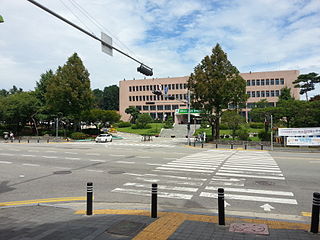 W
WSongtan is an area in the northern end of Pyeongtaek, Gyeonggido, South Korea. Songtan achieved city status in its own right in 1981, five years earlier than Pyeongtaek, but merged, along with Pyeongtaek County, into Pyeongtaek City in May 1995. Most residents still consider it to have an identity separate from the rest of Pyeongtaek City. To appease some discontent at the merger Pyeongtaek city officials decided to keep the Songtan City Hall intact and convert it into a branch office of the Pyeongtak City Hall, as shown in the picture above, where Songtan residents can still go for city provided services. At consolidation, Songtan had over 110,000 residents, slightly less than the population of pre-consolidation Pyeongtaek City. The district has an administrative office which formerly served as Songtan City Hall. Songtan's best known feature is Osan Air Base, a United States Air Force base which spawned the growth of the area and is a major factor in the district's economy.
 W
WWolgot is a dong, neighbourhood of Siheung in Gyeonggi Province southwest of Seoul and south of Incheon, bordering on Soraepogu. There is also a fishing harbor on the local ocean inlet, near which numerous high-rise apartment buildings are located. Several small hotels and seafood restaurants also serve visitors. In June 2012 a new subway station was opened on the Suin Line, a new subway line currently open between Seoul Subway Line 4 and the Incheon Subway Line 1 of the Seoul Metropolitan Subway system. Many buses also stop in Wolgot. On March 1, 2014, it was separated from Gunpo-dong.
 W
WWolseong-dong is an administrative dong or a neighbourhood in the administrative subdivisions of the Gyeongju City, North Gyeongsang province, South Korea. It consists of nine legal dong including Inwang-dong, Gyo-dong, Dongbang-dong, Doji-dong, Namsan-dong, Pyeong-dong, Guhwang-dong, Bomun-dong and Baeban-dong
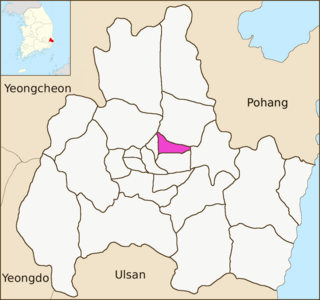 W
WYonggang-dong is both an administrative and legal dong or a neighbourhood in the administrative subdivisions of the Gyeongju City, North Gyeongsang province, South Korea. It is bordered by Bukgun-dong on the east, Deoksan-ri of Cheonbuk-myeon on the northeast, Hwangseong-dong and Dongcheon-dong on the south and Geumjang-ri of Hyeongok-myeon on the south. Its 5.06 square kilometers are home to about 15,817 people. It has two elementary schools, a middle school and a high school